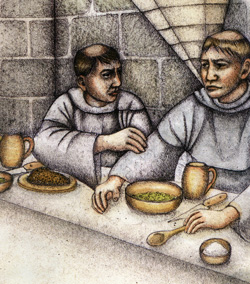|
|
You are here:
 The procedure at mealtimes
The procedure at mealtimes
(3/3)
The monks
did not wear their cowls in the refectory and ate in silence,
communicating essential
information
by making
signs with their fingers and hands.
Those who did
not observe silence were punished.(9) The
only voice to be heard was that
of the
reader,
who stood in a pulpit and edified the monks with readings from
the Bible or another holy book, for it was intended that the
monks should feed their minds as well as their bodies during
meals. Whilst
nothing remains of the pulpit at Roche its position in the
west wall is known from the thickening of the wall, just above
the
bridge, which was to accommodate the pulpit steps. It was important
that
the monks behaved appropriately in the refectory and had good
table manners. For example, drinking cups were to be held with
both hands,
the monks were to reach out for the salt with the tip of their
knives, and the used blade, like other dirty utensils, was
to be wiped on a piece of bread rather than on the napkin.
At table not only should the monks take food, but their
ears should draw their fill of the Word of God. No one should
concentrate
entirely on eating, but such attention should be given to
the Word of God that only the mouth takes food while the
ears take
the Word. If one receives less nutritious food than others,
then one’s joy should be greater. Those who bear privation
with zeal are truly blessed.
[Arnulph of Bohéries, Speculum Monachorum (A Mirror
for Monks) Patrologia Latina 184, col. 1175.]
|
Mealtimes were not an excuse for
frivolity or light-relief and the monks were expected to eat quickly.
Meals lasted for about
half an hour and concluded with a thanksgiving; the whole community
proceeded to the church for grace although if a distinguished visitor
was present this might be postponed, out of respect.(10) It
is important to note that the monastic refectory was reserved for
the monks
of the house and visiting Cistercians. The lay-brothers dined
in their own refectory in the western range and outsiders ate in
the
guesthouse with the abbot. Novices may
have dined in their own quarters in the undercroft of the monks’ dormitory
where, under the tutelage of the novice-master, they were schooled
in
Cistercian customs
<back> <next section>
|







